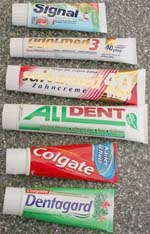Help for Sensitive Teeth

The sudden, sharp pain of sensitive teeth is familiar to most people. It is triggered by hot, cold, sweet or sour foods and beverages. In some people, it can be caused simply by breathing cold air.
This condition is caused when the dentin (the underlying layer of teeth) becomes exposed due to receding gums that cover the roots of the teeth. Since the roots are not covered by hard enamel, they allow whatever stimuli — hot or cold — to reach the nerves of your teeth. This, in turn, triggers the pain of sensitive teeth.
Among the many possible causes of tooth sensitivity are brushing too hard with a hard-bristled toothbrush that eventually destroys the enamel and causes the gums to recede, gum disease or gingivitis, cracked teeth that are invaded by bacteria, teeth grinding and the use of tooth whitening products containing peroxide and baking soda.
Over time, your teeth tend to become sensitive with old age. Acidic mouthwashes can make the problem worse. So will the regular consumption of acidic foods and drinks like citrus fruits, tomatoes, pickles and tea.
Tooth sensitivity can also follow routine tooth cleaning, crown placement and tooth restoration although this is only temporary and will disappear in four to six weeks.
To reduce tooth sensitivity, here are some helpful tips from WebMD and the Cleveland Clinic Department of Dentistry:
1.) Maintain good oral hygiene. Continue to follow proper brushing and flossing techniques to thoroughly clean all parts of your teeth and mouth.
2.) Use a soft bristled toothbrush. This will result in less toothbrush abrasion to the tooth surface and less irritation to your gums. Brush gently and carefully around the gum line so you do not remove more gum tissue.
3.) Use desensitizing toothpaste. There are several brands of toothpaste available for sensitive teeth. With regular use you should notice a decrease in sensitivity. You may need to try several different brands to find the product that works best for you. Another tip: spread a thin layer of the toothpaste on the exposed tooth roots with your finger or a Q-tip before you go to bed. Do not use tartar control toothpaste; rather, use fluoridated toothpaste.
4.) Watch what you eat. Frequent consumption of highly acid foods can gradually dissolve tooth enamel and lead to dentin exposure. They may also aggravate the sensitivity and start the pain reaction.
5.) Use fluoridated dental products. Daily use of a fluoridated mouth rinse can decrease sensitivity. Ask your dentist about available products for home use.
6.) Avoid teeth grinding. If you grind or clench your teeth, use a mouth guard at night.
7.) See your dentist at regular intervals. Get professional tooth cleaning, oral hygiene instructions, and fluoride treatments every six months (or sooner depending on your condition).
8.) If nothing happens, see your dentist. He or she may advise the use of white fillings or dentin sealers to cover the exposed root surface.
To complement your beautiful smile, use Lumnaderm, a whitening cream that eliminates freckles, unsightly age spots, sun spots, blemishes and hyperpigmentation. When used as directed, Lumnaderm will balance uneven skin tones and illuminate your skin.
About The Author:
Sharon Bell is an avid health and fitness enthusiast and published author. Many of her insightful articles can be found at the premier online news magazine www.HealthLinesNews.com.
|